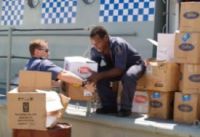Tsunami on Solomon Islands,death toll grows
The first boatloads of aid arrived in the Solomon Islands tsunami zone to aid desperate survivors, death toll nears 30.

Flights over remote coastal villages in the stricken Western Province of the islands on Tuesday reported widespread destruction, a local official said, as the death toll edged toward 30 and was expected to climb further.
There was still no official number for those missing more than a day after the combination punch of a powerful earthquake and killer waves struck on Monday morning. Thousands faced a second night sleeping outside on the higher ground where they fled to escape a 5-meter (17-foot) wall of water.
Solomons Deputy Police Commissioner Peter Marshall said boats arrived Tuesday morning in the towns of Gizo and in nearby Munda from Honiara, the capital, carrying food and other urgent supplies.
Some were distributed, while planes overflew outlying areas to try to determine where other aid was mostly badly needed. They spotted bodies floating in the water, as well as damaged roads and airstrips.
"There are some very ragged, remote areas and there's no connecting roads, (just) isolated villages," Marshall told Australian Broadcasting Corp. radio.
Julian Makaa, spokesman for the National Disaster Management Office, said officials could only guess at the numbers of dead in the remotest villages, where two-way radio is the usual mode of contact with the outside world.
Television footage shot from a helicopter that overflew parts of the coast outside Gizo, the area's main town, showed building after tin- or thatched-roof building collapsed along a muddy foreshore. Others leaned awkwardly on broken stilts.
The disaster also rekindled a scientific debate about whether multimillion-dollar warning systems being installed in response to the 2004 Indian Ocean tsunami are worth the cost, or whether more money should be spent simply on teaching people how to read the danger signs and get to high ground more quickly.
In Gizo, some of more than 2,000 people who spent Monday night encamped in hills behind the town after fleeing the surging waves returned looking for supplies or loved ones.
Most of the more than one dozen bodies found Tuesday were reported by people who discovered relatives in the remains of their shattered houses, said Arnold Moveni, head of the provincial disaster committee.
The confirmed death toll stood at 28 in the Solomons, Moveni said, and was expected to rise as more rubble was searched and outlying villages reached. Five unconfirmed deaths were reported in neighboring Papua New Guinea.
Makaa said at least 916 houses had been destroyed around Gizo and about 5,000 people affected, but that the final toll could be much higher. The Red Cross said about 2,000 of Gizo's 7,000 people were homeless. Officials said shortages would become dire within days without outside help.
"There is no food available" in Gizo and Noro, a nearby town, said government spokesman Alfred Maesulia. "Some settlements have been completely wiped out by the waves."
Outside Gizo, teams that flew over the coast reported the "destruction was massive and widespread," said Fred Fakarii, chairman of the National Disaster Management Council.
Among the dead were a bishop and three worshippers at a church on Simbo island, the Uniting Chursh said. A 53-year-old New Zealand man who drowned trying to save his mother from the waves, that country's leader said.
Australia, New Zealand, the International Red Cross and the United Nations were among those offering aid, but no formal relief plan was announced after a day of meetings by senior bureaucrats and government officials. More aerial reconnaissance was needed first, Fakarii said.
But Makaa said the airport had been cleared of debris and was expected to be assessed on Wednesday and certified as safe to use. Six doctors and 13 nurses would be among the first flown in to Munda and Gizo, where the region's only hospital was inundated, he said.
Most the homeless who spent Monday night sleeping under tarpaulins or the stars in hills behind Gizo faced a second night there on Tuesday. Scores of aftershocks, including multiple jolts of magnitude 6 or more, have shaken the region and many people remained to scared to return to town.
Monday's 8.1 magnitude quake struck at 7:39 a.m. 10 kilometers (six miles) beneath the sea floor, about 40 kilometers (25 miles) from Gizo, the U.S. Geological Survey said. Within five minutes, waves up to five meters (16 feet) high plowed into the coast, witnesses said.
U.S. earthquake expert Kerry Sieh, who has studied the Indian Ocean disaster, said Monday's event showed warning systems were of limited value to communities lying close to the epicenter of tsunami-causing quakes.
"When you have a tsunami coming in so quickly after an earthquake, it doesn't do much good to have an early warning system," he said, though he noted such systems could help communities farther away.
Officials would be better off putting more resources into disaster response education and efforts to permanently relocate vulnerable communities to higher ground, he said.
Michael Rottmann, the U.N. special coordinator for the early warning system in Indonesia, which was hardest hit by the 2004 tsunami that left 230,000 dead or missing, said warning systems would be useful if the message can get out quickly.
"I think a lot of lives can be saved if you have a warning in less than 10 minutes," Rottmann told The Associated Press. "If you have five minutes and you have a reliable warning, you can get very far ... up into a hill or away from the beach."
Monday's quake set off alarms from Tokyo to Hawaii, and caused officials to close beaches along the length of Australia's east coast. No significant tsunami was reported anywhere outside the Solomons' zone.
More than 200 islands with a population of about 552,000 people make up the Solomon Islands. They lie on the Pacific Basin's so-called "Ring of Fire," an arc of volcanos and fault lines where quakes are frequent.
Subscribe to Pravda.Ru Telegram channel, Facebook, RSS!





